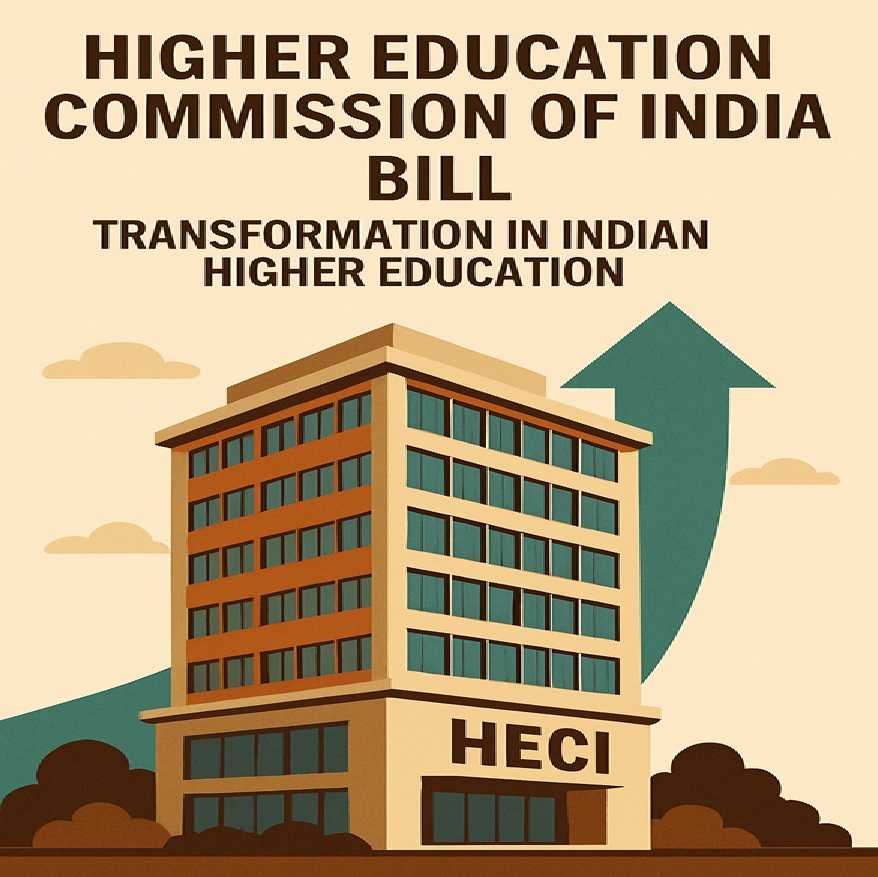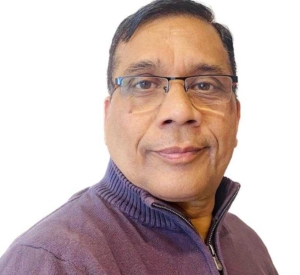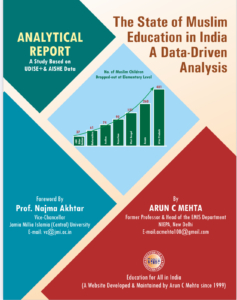Higher Education Commission of India (HECI) Bill: A Transformative Step for Indian Higher Education

Higher Education Commission of India (HECI) Bill
Background
The Ministry of Education (MoE), Government of India, is actively drafting a bill to establish the Higher Education Commission of India (HECI), as announced by Union Minister of State for Education, Sukanta Majumdar, in a written reply to the Lok Sabha on July 21, 2025. This initiative is rooted in the National Education Policy (NEP) 2020, which envisions a “light but tight” regulatory framework to promote integrity, transparency, and resource efficiency in higher education while encouraging innovation, autonomy, and good governance. The HECI is proposed as a unified regulatory body to replace the University Grants Commission (UGC), the All India Council for Technical Education (AICTE), and the National Council for Teacher Education (NCTE), streamlining oversight of non-technical, technical, and teacher education, respectively.
The concept of HECI was first introduced through the draft Higher Education Commission of India (Repeal of University Grants Commission Act) Bill, 2018, which sought to repeal the UGC Act of 1956 and was opened for public feedback. Progress was revitalized under Union Education Minister Dharmendra Pradhan in July 2021. The NEP 2020 underscores the need for a single regulator to address inefficiencies in the current fragmented system, aligning India’s higher education with global standards.
Recommendation and Rationale
The HECI proposal originates from the NEP 2020, formulated by a committee led by Dr. K. Kasturirangan, former Chairman of the Indian Space Research Organisation (ISRO). The NEP identifies the fragmented regulatory framework—comprising UGC, AICTE, and NCTE – as a barrier to efficiency, innovation, and quality assurance. A unified HECI with independent verticals for regulation, accreditation, funding, and academic standard-setting aims to create a cohesive system that fosters interdisciplinary education, aligns with industry needs, and enhances global competitiveness.
Drawing from international examples:
- United Kingdom: The Office for Students (OfS), established under the Higher Education and Research Act 2017, serves as a single regulator overseeing higher education. It focuses on student outcomes, quality assurance, and institutional autonomy while ensuring accountability through data-driven assessments and public disclosures.
- Australia: The Tertiary Education Quality and Standards Agency (TEQSA) regulates higher education under the Tertiary Education Quality and Standards Agency Act 2011. TEQSA adopts a risk-based approach, granting autonomy to high-performing institutions while closely monitoring those with compliance issues, ensuring both flexibility and quality.
- United States: The U.S. Department of Education works with independent accrediting agencies, such as the Higher Learning Commission, to ensure quality through peer-reviewed accreditation. This decentralized model emphasizes institutional autonomy balanced with rigorous standards.
These models highlight the effectiveness of unified or coordinated regulatory systems, offering lessons for HECI in balancing autonomy with accountability and aligning with global benchmarks.
Implications for Higher Education
The establishment of HECI is poised to transform India’s higher education landscape:
- Unified Regulation: By consolidating UGC, AICTE, and NCTE, HECI will eliminate overlapping functions, streamline compliance, and create a unified quality assurance framework, similar to the UK’s OfS or Australia’s TEQSA.
- Enhanced Autonomy: The “light but tight” approach, inspired by global models like TEQSA’s risk-based regulation, will grant HEIs greater autonomy while ensuring accountability through audits and transparency.
- Improved Efficiency: A single regulator will simplify funding, accreditation, and standard-setting processes, reducing bureaucratic delays for institutions, akin to the UK’s OfS model.
- Quality Assurance: Independent accreditation and standard-setting verticals, inspired by the U.S. peer-review system, will ensure consistent quality across technical, non-technical, and teacher education.
- Global Competitiveness: By adopting best practices from the UK, Australia, and the U.S., HECI can enhance India’s higher education appeal for international students and faculty.
- Challenges: Transitioning to HECI may face resistance from existing bodies, require capacity-building, and need safeguards to prevent over-centralization, a concern raised in the UK’s OfS implementation.
Proposed Structure and Responsibilities of HECI
HECI is envisioned to operate with four independent verticals, drawing inspiration from international models. Below is a proposed structure, including roles, merger recommendations, and lessons from global examples:
| Vertical | Role and Responsibilities | Existing Body to Merge | Recommendations (Inspired by Global Examples) |
|---|---|---|---|
| Regulation | Oversee compliance, governance, and policy enforcement for all HEIs. Ensure autonomy with accountability. | UGC, AICTE, NCTE (Regulatory functions) | Adopt a risk-based approach like Australia’s TEQSA, granting autonomy to high-performing HEIs while monitoring others closely. |
| Accreditation | Establish and monitor accreditation standards, conduct quality assessments, and ensure public disclosure. | NAAC, NBA | Implement peer-reviewed accreditation like the U.S. model, ensuring global benchmarks and periodic reviews for credibility. |
| Funding | Allocate funds based on performance, innovation, and societal impact. Promote equitable resource distribution. | UGC (Funding functions) | Introduce a performance-based funding model, as seen in the UK’s OfS, to incentivize research and quality education. |
| Academic Standard Setting | Set academic standards, curricula frameworks, and promote interdisciplinary education aligned with NEP 2020. | UGC, AICTE, NCTE (Standard-setting functions) | Foster flexible, industry-relevant curricula, drawing from the UK’s emphasis on employability and innovation in education. |
Recommendations for Merger
- UGC: Absorb its regulatory, funding, and standard-setting functions into HECI’s respective verticals. Its non-technical education oversight should integrate into the academic standard-setting vertical, ensuring alignment with interdisciplinary goals.
- AICTE: Merge its technical education functions into the regulation and academic standard-setting verticals, ensuring technical education aligns with broader higher education objectives, similar to Australia’s unified approach.
- NCTE: Integrate its teacher education functions into the academic standard-setting and accreditation verticals, focusing on enhancing teacher training quality, drawing from the UK’s emphasis on professional standards.
- NAAC and NBA: Merge into HECI’s accreditation vertical to create a unified framework, adopting a U.S.-style peer-review system to ensure consistency and global alignment.
Concluding Observations
The drafting of the HECI bill, inspired by the NEP 2020, marks a pivotal step toward modernizing India’s higher education system. By consolidating UGC, AICTE, and NCTE into a single regulator, HECI aims to address inefficiencies, enhance autonomy, and elevate quality, drawing lessons from global models like the UK’s OfS, Australia’s TEQSA, and the U.S. accreditation system. However, successful implementation will require robust stakeholder consultation, transparent processes, and safeguards against over-centralization, as observed in international transitions. Capacity-building and alignment with global benchmarks will be critical to ensuring HECI’s effectiveness. If executed thoughtfully, HECI can position India’s higher education system as a global leader, fostering innovation, equity, and excellence. At the same time, it would also be an opportunity to rebuild the state-run universities on the verge of collapse because of a lack of regular faculty and resources.
Suggested Readings
- Ministry of Education, Government of India. (2020). National Education Policy 2020.
- Economic Times Education. (2025, July 21). MoE in process of drafting bill for unified higher education body: MoS to Lok Sabha.
- Draft Higher Education Commission of India (Repeal of University Grants Commission Act) Bill, 2018.
- Office for Students (OfS), UK. (2023). About the Office for Students.
- Tertiary Education Quality and Standards Agency (TEQSA), Australia. (2023). TEQSA’s Role and Functions.
- U.S. Department of Education. (2023). Accreditation in the United States.


